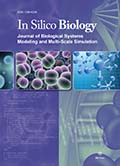Authors: Ganesh, Aparna B. | Rajasingh, Hannah | Mande, Sharmila S.
Article Type:
Research Article
Abstract:
Salmonella enterica serovar Typhimurium invades the intestinal epithelial cells using type three secretion system (TTSS) encoded on Salmonella pathogenicity island-1 (SPI-1). The key regulator of this secretion system is HilA, which is in turn regulated by HilD, HilC and RtsA. It is also known that SirA/BarA system, a two-component regulatory system plays a crucial role in regulating HilA. There are two different mechanisms that have been proposed earlier for regulation of HilD-HilC-RtsA-HilA network by
…SirA. One considers SirA to be acting through HilA and HilC, whereas the other considers SirA to be acting through HilD. In this paper, we have built mathematical models corresponding to both these scenarios and carried out simulations under different gene knock-out conditions. Additionally, since the two proposed mechanisms based on the experimental data are equally likely, we also considered a mechanism which is a combination of the two proposed mechanisms. The simulations were carried out to check the levels of HilA, the factor regulating the virulence, as well as the levels of the intermediate components in the network, namely HilC and RtsA. The simulation results were used to check the consistency of various models and also to suggest the most probable mechanism of hilA regulation. The results of our study show that while most of the mathematical models are able to predict the virulence data, the models considering SirA to regulate through HilA and HilC fail to predict the levels of intermediate components, HilC and RtsA. Nevertheless, one of the models considering regulation of virulence by SirA via HilD was able to predict results comparable to the experimental data. In addition, combination of this model (regulation by SirA via HilD) with the model considering regulation by SirA through HilA and HilC, also predicted results consistent with experimental observations. Our conclusions were further validated by testing the stability of the results against changes in parameter values, thus confirming the relative robustness of the proposed modeling system.
Show more
Keywords: Salmonella, pathogenicity, type three secretion system, virulence, HilA, SirA, mathematical modeling
DOI: 10.3233/ISB-2009-0380
Citation: In Silico Biology,
vol. 9, no. 1-2, pp. S57-S72, 2009
Price: EUR 27.50




